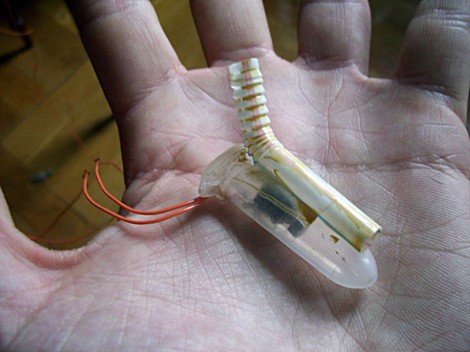
This is [Lee von Kraus’] new experimental propulsion system for an underwater ROV. He developed the concept when considering how one might adapt the Bristlebot, which uses vibration to shimmy across a solid surface, for use under water.
As with its dry-land relative, this technique uses a tiny pager motor. The device is designed to vibrate when the motor spins, thanks to an off-center weight attached to the spindle. [Lee’s] first experiment was to shove the motor in a centrifuge tube and give it an underwater whirl. He could see waves emanating from the motor and travelling outward, but the thing didn’t go anywhere. What he needed were some toothbrush bristles. He started thinking about how those bristles actually work. They allow the device to move in one direction more easily than in another. The aquatic equivalent of this is an angled platform that has more drag in one direction. He grabbed a bendy straw, using the flexible portion to provide the needed surface.
Check out the demo video after the break. He hasn’t got it connected to a vessel, but there is definitely movement.














IANANE (heh, I am not a nautical engineer is inane.. nice) a second bendy straw on the other side could then cause direct forward motion, steering by removing the straws from the surface somehow.. interesting
I actually tried two straws, one on each side and the vehicle didn’t move at all when I did that. I also tried adding small, unidirectional bristles to the outside and it didn’t move then either. So I don’t think the movement is due to more resistance on one side than the other.
The vehicle only moved when I put a single bendy straw on one side (asymmetrical). In that case I saw standing vortices all around the hull, I think the asymmetry is causing vortices to exert different amounts of force on different sides of the vehicle.
This works at low Reynolds numbers, but at the size that little thing is getting, he’s going to have a little trouble.
Very very tiny bristlebots work quite well in water. Biologists call them ciliates.
Wonder what would happen if it were designed like a flagellate.
Like I mentioned in my other reply to David, when I tried bristles it didn’t actually move, so you are correct in that small reynolds numbers seem to be required for that technique to work.
Only when I used a single bendy straw on one side did it start moving. As far I can tell the movement is being caused by forces exerted by asymmetrical standing vortices.
Why not just put a propeller on that vibration motor????
;)
That’s not the point of a bristlebot. They’re supposed to provide a more random style of motion.
An ideal design would have a bunch of tiny angled attachments, thus it would get random motion. It would be really cool if he weighted it such that it didn’t float or sink, too.
I did try weighting it (put some pebbles in there) and got it to drive around while fully submerged too, it was a pleasant surprise.
because you would have to make a waterproof connection between the motor and propeller which can be quite hard
Because then the propeller is exposed to corrosion and marine life.
You realize its a little plastic thing in a tub right? This isn’t a full sized vehicle and never will be.
The first thing that came to mind when reading ‘Vortex-drive’ and seeing the pic was a screw prop inside the straw that was being rotated via magnetism. The actual project isn’t quite so intricate or efficient, but still really nice.
I wonder if just a mildly flexible fin would do anything. Hmm…have to find me some junk pagers and cell phones…
I tried cutting lots of little (~1mm width) bristles out of another straw and taped those all around the vehicle but that didn’t cause movement. But I see what you’re getting at, just a single flappy thing at the back; That would be really cool, I’ll try that out and let you know if it works, but you should try it too since maybe you’ll find a better material to use.
Soon McGyver builds a torpedo out of a vibrator and a hand granade
Second that one!
Couldn’t he just attach a magnet to the end of the motor instead of a weight. The propeller could have a matching magnet on the outside, no physical connection necessary.
that’s been done before in other ROVs but it requires a rotating magnet/propeller on the outside of the vehicle. I imagined that it would be hard to keep the junction between the magnet and the vehicle smooth-sliding, and it would be a more complex/harder to build/maintain system.
Solar-powered static charge caterpillar drive. 9th grade science fair. You can have that one.
Would be neat to try to make a mini hydrofoil like this: http://www.youtube.com/watch?v=In8f0C_B9HA
You need to mount the motor such that its axis is perpendicular to the desired direction. ie perpendicular to the straw.
For me the following works well, and fits much of the DIY community in general, even if they need to use new items in a build to get it right;
Repurpose, reuse, invent, and recycle.” Not just duct taping stuff together, it applies to code, ideas, whatever. — Ian Lesnet, Dangerous Prototypes
From the look of it, the axis of rotation is parallel to the “desired” motion (well, by the shape of the thing). That works on friction based bristle bots, but because the resulting motion is up and down (with the “random” aspect a result of side to side motion coupled with small changes friction).
You would get better results if you made it perpendicular to the motion you want, and then you should be able to use the ramp/bristle ideas set before.